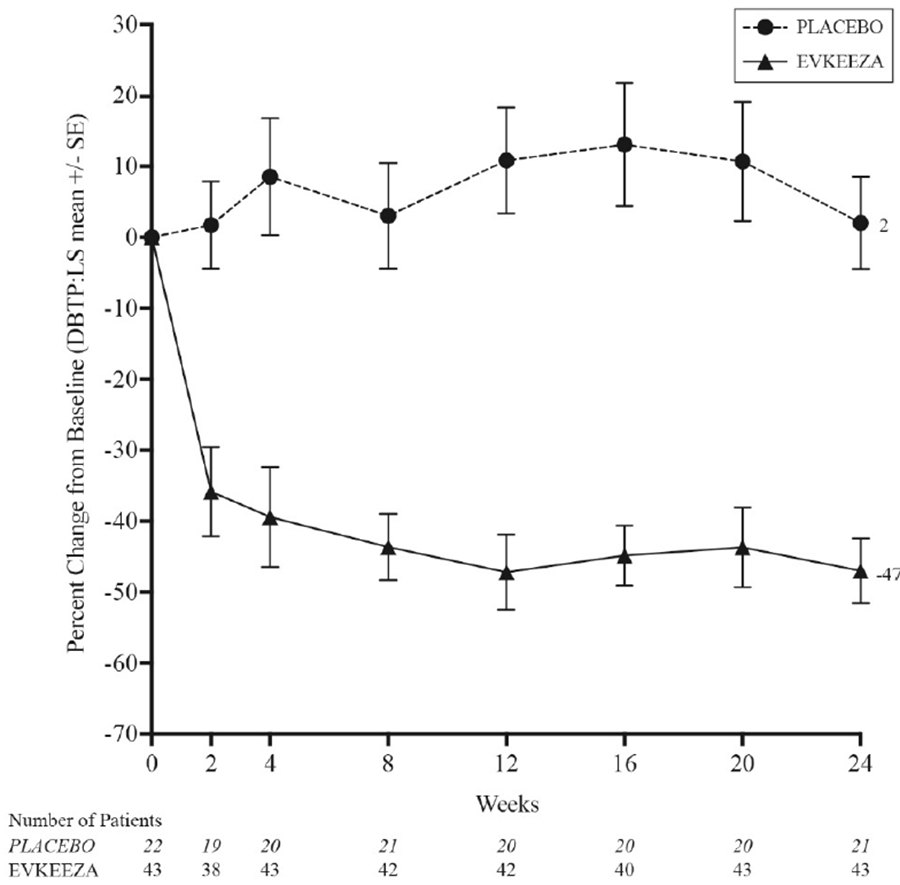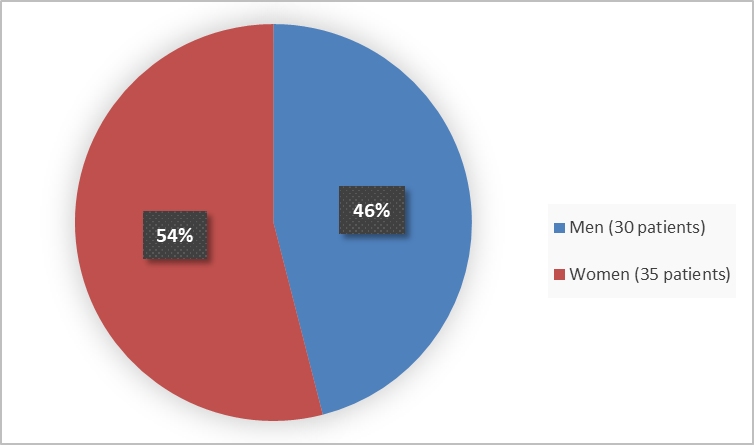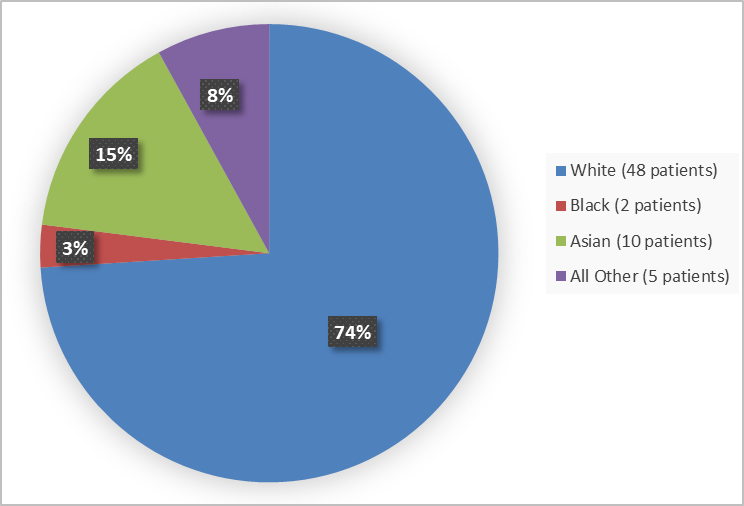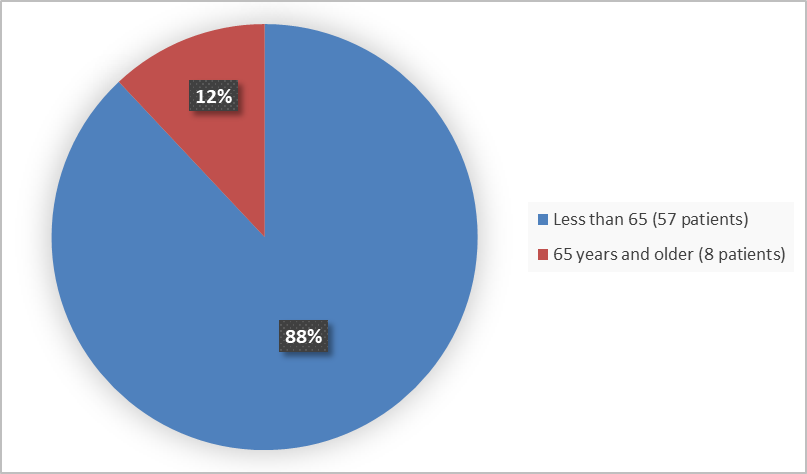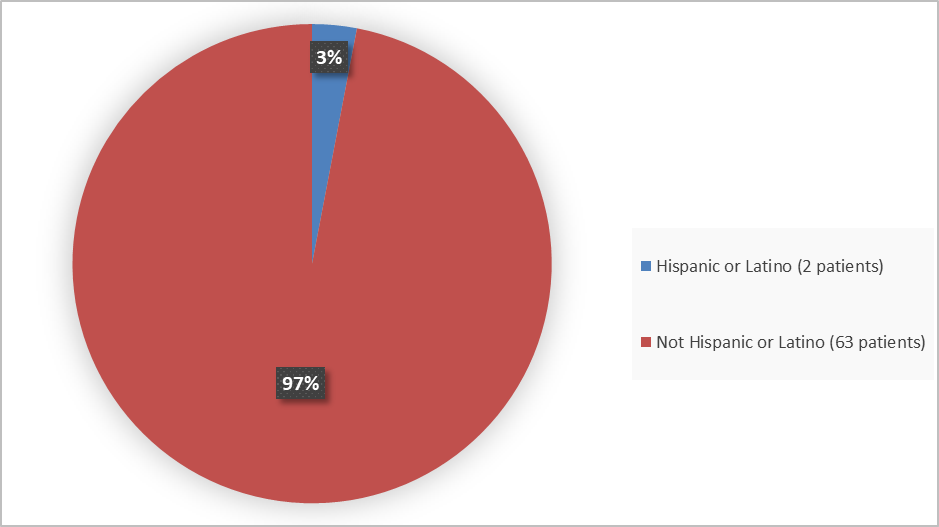Drug Trial Snapshot: EVKEEZA
HOW TO USE THIS SNAPSHOT
The information provided in Snapshots highlights who participated in the key clinical trials that supported the original FDA approval of this drug, and whether there were differences among sex, race, age, and ethnic groups. The “MORE INFO” bar shows more detailed, technical content for each section. The Snapshot is intended as one tool for consumers to use when discussing the risks and benefits of the drugs.
LIMITATIONS OF THIS SNAPSHOT:
Do not rely on Snapshots to make decisions regarding medical care. Always speak to your healthcare provider about the benefits and risks of a drug.
Some of the information in this Snapshot is for presentation purposes and does not represent the approved conditions of use of this drug. Refer to the EVKEEZA Prescribing Information for all of the approved conditions of use of this drug (e.g., indication(s), population(s), dosing regimen(s), safety information).
Snapshots are limited to the information available at the time of the original approval of the drug and do not provide information on who participated in clinical trials that supported later approvals for additional uses of the drug (if applicable).
EVKEEZA (evinacumab-dgnb)
(ev kee' zah)
Regeneron Pharmaceuticals, Inc.
Approval date: February 11, 2021
DRUG TRIALS SNAPSHOT SUMMARY:
What is the drug for?
EVKEEZA is a prescription medicine used along with other low-density lipoprotein (LDL) lowering medicines in people older than 12 years of age with a type of high cholesterol called homozygous familial hypercholesterolemia (HoFH).
How is this drug used?
EVKEEZA is given into the vein through an intravenous (IV) line every month (4 weeks).
What are the benefits of this drug?
In the clinical trial, participants who received EVKEEZA had a 49% reduction in LDL cholesterol compared to participants who received placebo (see Glossary below) after 24 weeks of treatment.
What are the benefits of this drug (results of trials used to assess efficacy)?
The table below summarizes changes in LDL cholesterol at week 24 for EVKEEZA compared with placebo.
Table 1. Percent Change in LDL-C After 24 Weeks of Treatment in Participants with HoFH on Other Lipid-Lowering Therapies in Trial ELIPSE-HoFH
|
Percent Change LDL-C (95% CI) |
|
|
|---|---|---|
|
EVKEEZA |
Placebo |
Treatment Difference |
|
-47% |
+2% |
-49% (-65 to -33) |
FDA Statistical Review
The figure below shows the percent change in LDL cholesterol over time.
Figure 1. Percent Change in LDL Cholesterol Over Time in Trial ELIPSE-HoFH
Abbreviations: LS mean=least squares mean, HoFH=homozygous familial hypercholesterolemia, DBTP=double-blind treatment period, SE=standard error
Were there any differences in how well the drug worked in clinical trials among sex, race and age?
- Sex: EVKEEZA worked similarly in men and women.
- Race: EVKEEZA worked similarly in White and Asian participants. The number of participants of other races was limited; therefore, differences in response for other races could not be determined.
- Age: The number of participants above 65 years of age was small; therefore, differences in response according to age could not be determined.
Were there any differences in how well the drug worked in clinical trials among sex, race, and age groups?
The table below summarizes the primary efficacy endpoint, the mean percent LDL-C change after 24 weeks of treatment, by demographic subgroups. As shown in Table 2 below, participants experienced reductions in LDL-C regardless of sex or race (White or Asian).
Table 2. Subgroup Analysis: Percent Change in LDL-C After 24 Weeks of Treatment
|
Demographic Parameter |
LDL-C change (%) |
|
|
|---|---|---|---|
|
|
Placebo |
EVKEEZA |
Differencea |
|
Sex: Male |
-6.0 |
-48.5 |
-48.0 |
|
Female |
10.1 |
-46.0 |
-50.4 |
|
Race: White |
2.2 |
-46.2 |
-48.0 |
|
Asian |
-8.9 |
-42.0 |
-46.1 |
a Treatment differences and credible intervals may not match values of (treatment - control) since estimates include relevance of outcomes from other subgroups.
Abbreviations: LDL-C=low-density lipoprotein cholesterol, 95% CI=95% confidence interval
FDA Statistical Review
What are the possible side effects?
EVKEEZA can cause serious allergic reactions (hypersensitivity), including a severe reaction known as anaphylaxis. Symptoms may include:
- Swelling of the lips, tongue, or throat which makes it difficult to swallow or breathe
- Breathing problems or wheezing
- Feeling dizzy or fainting
- Rash, hives
- Itching
In addition, taking EVKEEZA may cause fetal harm and any effects from breastfeeding are unknown.
The most common side effects of EVKEEZA include:
- Symptoms of the common cold
- Flu-like symptoms
- Dizziness
- Pain in legs or arms
- Nausea
- Decreased energy
Were there any differences in side effects of the clinical trials among sex, race, and age?
- Sex: The occurrence of side effects was similar in men and women.
- Race: The occurrence of side effects was similar in White and Black or African American participants.
- Age: The number of participants 65 years of age and older was small, therefore differences in side effects could not be determined.
WHO WAS IN THE CLINICAL TRIALS?
Who participated in the clinical trials?
The FDA approved EVKEEZA based on data from a clinical trial (ELIPSE-HoFH) that enrolled 65 participants with HoFH. The trial was conducted in the United States, Italy, France, Greece, Netherlands, Austria, Canada, Australia, New Zealand, Ukraine, South Africa, and Japan.
Figure 2 below summarizes how many men and women were enrolled in the clinical trial.
Figure 2. Baseline Demographics by Sex (Efficacy Population)
Figure 3 summarizes the percentage of participants by race enrolled in the clinical trial.
Figure 3. Baseline Demographics by Race (Efficacy Population)
Figure 4 summarizes the percentage of participants by age enrolled in the clinical trial.
Figure 4. Baseline Demographics by Age (Efficacy Population)
Figure 5 summarizes the percentage of participants by ethnicity enrolled in the clinical trial.
Figure 5. Baseline Demographics by Ethnicity (Efficacy Population)
How were the trials designed?
The benefits and side effects of EVKEEZA was evaluated in one clinical trial of 65 participants with HoFH.
Enrolled participants were already using other treatments to lower LDL cholesterol, including drugs (the highest dose of a statin, ezetimibe, PCSK9 inhibitor antibodies, lomitapide) and lipoprotein apheresis (a medical procedure to remove cholesterol from blood). Participants were randomly assigned to receive EVKEEZA or placebo every month for 24 weeks. Neither the participants nor the health care providers knew which treatment was being given. After 24 weeks, all participants received EVKEEZA every month for an additional 24 weeks.
The trial measured percent change in LDL cholesterol from baseline (before treatment) to week 24 and compared EVKEEZA to placebo.
GLOSSARY
CLINICAL TRIAL: Voluntary research studies conducted in people and designed to answer specific questions about the safety or effectiveness of drugs, vaccines, other therapies, or new ways of using existing treatments.
COMPARATOR: A previously available treatment or placebo that is compared to the actual drug being tested.
EFFICACY: How well the drug achieves the desired response when it is taken as described in a controlled clinical setting, such as during a clinical trial.
PLACEBO: An inactive substance or “sugar pill” that looks the same as, and is given the same way as, an active drug or treatment being tested. The effects of the active drug or treatment are compared to the effects of the placebo.
SUBGROUP: A subset of the population studied in a clinical trial. Demographic subsets include sex, race, and age groups.
EVKEEZA Prescribing Information

